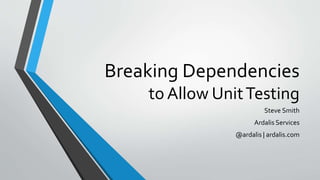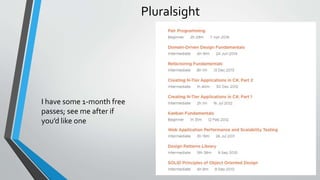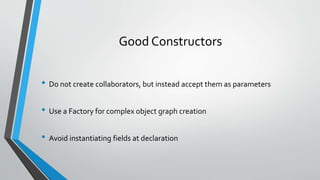Breaking Dependencies to Allow Unit Testing - DevIntersection Spring 2016
- 1. Breaking Dependencies to Allow UnitTesting Steve Smith Ardalis Services @ardalis | ardalis.com
- 2. Tweet Away • LiveTweeting and Photos are encouraged • Questions and Feedback are welcome • Use #DevIntersection and/or #breakDependencies • Or #DevIntersectionBreakingDependenciesToAllowUnitTesting (55 chars with space)
- 3. Pluralsight I have some 1-month free passes; see me after if you’d like one
- 4. Questions up Front What kinds of dependencies in your code cause you the most pain today?
- 5. Legacy Code “To me, legacy code is simply code without tests.” Michael Feathers Working Effectively with Legacy Code
- 6. UnitTesting (Legacy) Code is…
- 8. Hollywood made a whole movie about it…
- 9. But let’s back up… • Why UnitTests? • Why not just use other kinds of tests? • What are dependencies? • How do we break these dependencies?
- 10. UnitTests Prevent SmallThermal Exhaust Ports inYour Code
- 11. UnitTest Characteristics • Test a single unit of code • A method, or at most, a class • Do not test Infrastructure concerns • Database, filesystem, etc. • Do not test “through” the UI • Just code testing code; no screen readers, etc.
- 12. UnitTests are (should be) FAST • No dependencies means 1000s of tests per second • Run them constantly
- 13. UnitTests are SMALL • Testing one thing should be simple • If not, can it be made simpler? • Should be quick to write
- 14. UnitTest Naming • Descriptive And Meaningful Phrases (DAMP) • NameTest Class: ClassNameMethodName • NameTest Method: DoesSomethingGivenSomething • http://ardalis.com/unit-test-naming-convention
- 15. Seams • Represent areas of code where pieces can be decoupled • Testable code has many seams; legacy code has few, if any
- 17. Ask yourself: •Can I test this scenario with a UnitTest? •Can I test it with an IntegrationTest? • Can I test it with an automated UITest? UI Integration Tests UnitTests
- 18. Don’t believe your test runner… IntegrationTest
- 19. UnitTest? • Requires a database or file? • Sends emails? • Must be executed through the UI? Not a unit test
- 20. Dependencies and Coupling All dependencies point toward infrastructure Presentation Layer Business Layer Infrastructure Data Access Tests Tests (and everything else) now depend on Infrastructure
- 21. Dependency Inversion Principle High-level modules should not depend on low-level modules. Both should depend on abstractions. Abstractions should not depend on details. Details should depend on abstractions. Agile Principles, Patterns, and Practices in C#
- 22. Depend on Abstractions All dependencies point toward Business Logic / CorePresentation Layer Business Layer Infrastructure DataAccess UnitTests IntegrationTestsUITests
- 23. Inject Dependencies • Classes should follow Explicit Dependencies Principle • http://deviq.com/explicit-dependencies-principle • Prefer Constructor Injection • Classes cannot be created in an invalid state https://flic.kr/p/5QsGnB
- 24. Common Dependencies to Decouple •Database •File System •Email •Web APIs •System Clock •Configuration •Thread.Sleep •Random
- 25. Tight Couplers: Statics and new • Avoid static cling • Calling static methods with side effects • Remember: new is glue • Avoid gluing your code to a specific implementation • Simple types and value objects usually OK http://ardalis.com/new-is-glue
- 26. Coupling Code Smells • Learn more in my Refactoring Fundamentals course on Pluralsight • http://www.pluralsight.com/courses/refactoring-fundamentals • Coupling Smells introduce tight coupling between parts of a system
- 27. Feature Envy • Characterized by many getter calls • Violates the “Tell, Don’tAsk” principle • Instead, try to package data and behavior together • Keep together things that change together • Common Closure Principle – Classes that change together are packaged together
- 30. Law of Demeter • Or the “StronglyWorded Suggestion of Demeter” • A Method m on an object O should only call methods on • O itself • m’s parameters • Objects created within m • O’s direct fields and properties • Global variables and static methods
- 31. Law of Demeter
- 32. Law of Demeter
- 33. Law of Demeter
- 35. Constructors
- 36. Explicit Dependencies Principle • Methods and classes should require their collaborators as parameters • Objects should never exist in an invalid state http://deviq.com/explicit-dependencies-principle/
- 37. Constructor Smells • new keyword (or static calls) in constructor or field declaration • Anything more than field assignment! • Database access in constructor • Complex object graph construction • Conditionals or Loops
- 38. Good Constructors • Do not create collaborators, but instead accept them as parameters • Use a Factory for complex object graph creation • Avoid instantiating fields at declaration
- 39. “ ” IoC Containers are just factories on steroids. Don’t be afraid to use them where they can help
- 44. Avoid Initialize Methods • Moving code out of the constructor and into Init() • If called from constructor, no different • If called later, leaves object in invalid state until called • Object has too many responsibilities • If Initialize depends on infrastructure, object will still be hard to test
- 47. “Test” Constructors • “It’s OK, I’ll provide an “extra” constructor my tests can use!” • Great! As long as we don’t have to test any other classes that use the other constructor.
- 49. Avoid Digging into Collaborators • Pass in the specific object(s) you need • Avoid using “Context” or “Manager” objects to access additional dependencies • Violates Law of Demeter: Context.SomeItem.Foo() • Suspicious Names: environment, principal, container • Symptoms:Tests have mocks that return mocks
- 52. Avoid Global State Access • Singletons • Static fields or methods • Static initializers • Registries • Service Locators
- 53. Singletons • Avoid classes that implement their own lifetime tracking • GoF Singleton Pattern • It’s OK to have a container manage object lifetime and enforce having only a single instance of a class within your application
- 56. Breaking Dependencies inWeb Forms Demo
- 58. Summary • Inject Dependencies • Remember “New is glue”. • Keep yourAPIs honest • Remember the Explicit Dependencies Principle.Tell your friends. • Maintain seams and keep coupling loose
- 59. Thanks! • Questions? • Follow me at @ardalis • Check out http://DevIQ.com for more on these topics • Take Pride inYour Code! • References • http://misko.hevery.com/code-reviewers-guide/ • Working Effectively with Legacy Code by Michael Feathers Please use Event Board to fill out a session evaluation.
Editor's Notes
- #3: https://twitter.com/hashtag/devintersection https://twitter.com/hashtag/breakdependencies Set low expectations
- #6: And specifically, we want fast, automated tests.
- #8: Developers like to build things, but often the way they connect parts of an application together (if there even are separate parts) is like using super glue. Good luck testing the interface of one building block.
- #9: If you haven’t seen it yet, you should. This guy wants to use krazy glue to keep anything from changing. Probably not how we want our software to be designed.
- #10: I want to answer these questions in this session. 1. 2. 3.
- #14: …unless the system is difficult to break apart
- #15: Avoid names that provide no information: CustomerTests Test1 Test2 Test3
- #16: PC (seams) vs. MAC (no seams) PC – Power supply goes bad. Solution: Order new power supply, open case, replace. MAC – Power supply goes bad. Solution: Buy a new Mac.
- #17: Because they’re small and fast, you should have a lot of unit tests. They should be the foundation of your testing approach. Integration tests can include tests of services that sit between different layers of your application. Defense in Depth These aren’t the only kinds of tests
- #18: Test at the lowest level you can, since that will be the least expensive test to write, run, and maintain.
- #19: ReSharper calls any test you run a unit test, regardless of what kind of test it actually is.
- #20: Also, they shouldn’t be terribly complex, slow, or involve more than one or two classes.
- #21: Dependencies are transitive. If A depends on B and B depends on C, then A depends on C. When I talk about breaking dependencies, I’m also talking about reducing coupling. Loosely coupled code can be tested more easily, since there are fewer connections to have to break apart, and they’re easier to swap out.
- #29: This can be difficult to test, especially if either of the two classes in question are difficult to set up in a particular state. To fix this, move the behavior where it belongs.
- #30: This can of course be refactored further to eliminate the conditional complexity, using inheritance or a compositional pattern.
- #31: “Well, the code is more like guidelines than rules.” Assume as little as possible about collaborators’ collaborators Law of Demeter is not just about having two many dots in an expression.
- #32: Imagine when you order a pizza, the delivery person uses code like this to get paid. Does this seem to model how things actually work? Should the delivery person have access to your wallet and its contents? What if you don’t have a wallet? This code is now tightly coupled not only to a Customer, but to a Wallet and its implementation.
- #33: What if instead the Customer could respond to requests for payment, like this? Note that wallet is no longer exposed outside of the Customer class.
- #34: At this point, the original code makes a bit more sense. Payment is requested, and how it is achieved is no longer a concern of the calling code. Payment can come from a money clip, purse, or from under a mattress and this code will still work. Testing this code could use a simplified fake customer and wouldn’t require implementation of both a fake customer and a fake wallet, making test code simpler. Reduce coupling – keep your classes from having to know too much about the details of their collaborators.
- #35: Drink water
- #38: Constructors should be extremely simple. They shouldn’t choose the object’s collaborators, or how the object is retrieved from persistence. These things violate the Single Responsibility Principle for the constructor’s class, and tightly couple the class to certain implementation details. Constructors that accept collaborators provide seams – hard-coding collaborators erases such seams. New is probably OK for initializing simple things like strings, datetimes, or collections to avoid nulls. Prefer the new C# 6 syntax for this with properties.
- #39: Note, it’s fine to create simple types and value objects – simply consider whether it’s making the object harder to test or not when deciding.
- #41: This code is difficult to test and tightly coupled to a dbContext, which in this case probably makes it impossible to test this code without a database.
- #42: Note that in this case the only thing the constructor does is assign parameters to fields, and no fields are instantiated as part of their declaration.
- #43: Likewise, avoid making static lookup calls or assignments within a constructor, especially ones that depend on infrastructure or the local environment. Avoid depending on configuration directly – remember it’s a dependency.
- #44: The solution is the same – avoid creating things in the constructor in favor of passing these things in. If you can’t pass in the thing itself, pass in a means of getting to it (like we’re doing with IConfig in this case), but keep it simple as possible.
- #47: Dependency injection again saves the day. The initialization logic is a separate responsibility from whatever the service does, and so belongs in another class.
- #53: Adds coupling in an invisible, hard to track manner. Makes testing difficult, especially parallel testing or testing in any order Causes Spooky Action at a Distance – your method causes some unexpected behavior in some other part of the system
- #55: Third party library with static call
- #56: Use a wrapper and inject



























































